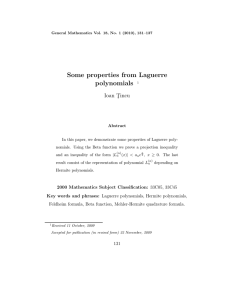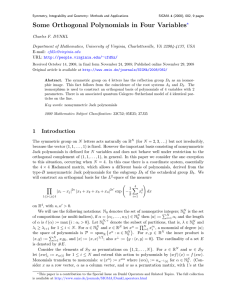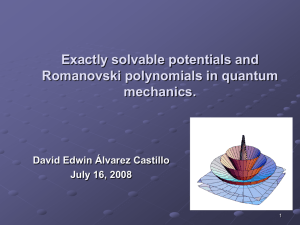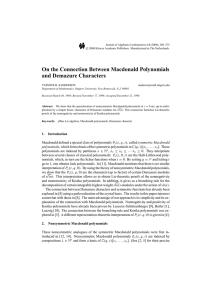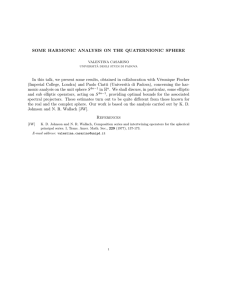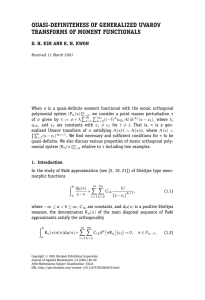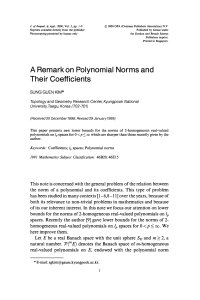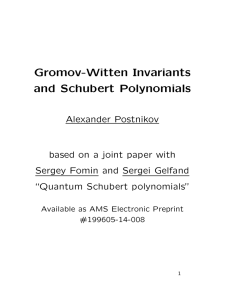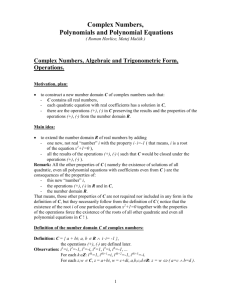Pieri’s formula for generalized Schur polynomials Yasuhide Numata
advertisement
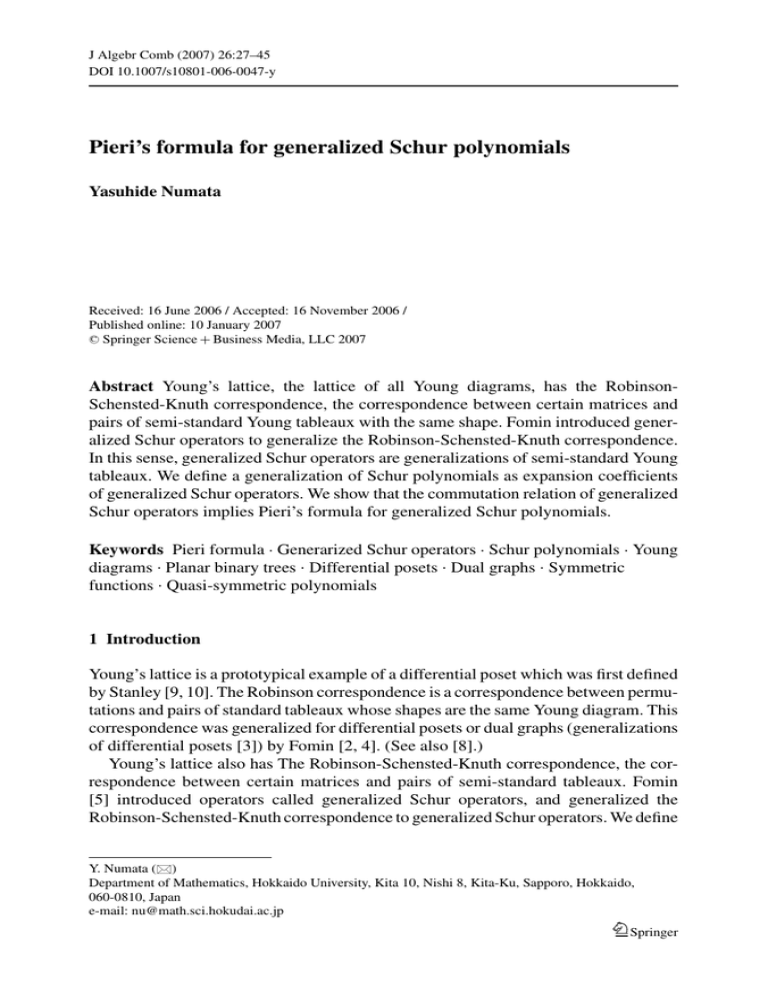
J Algebr Comb (2007) 26:27–45
DOI 10.1007/s10801-006-0047-y
Pieri’s formula for generalized Schur polynomials
Yasuhide Numata
Received: 16 June 2006 / Accepted: 16 November 2006 /
Published online: 10 January 2007
C Springer Science + Business Media, LLC 2007
Abstract Young’s lattice, the lattice of all Young diagrams, has the RobinsonSchensted-Knuth correspondence, the correspondence between certain matrices and
pairs of semi-standard Young tableaux with the same shape. Fomin introduced generalized Schur operators to generalize the Robinson-Schensted-Knuth correspondence.
In this sense, generalized Schur operators are generalizations of semi-standard Young
tableaux. We define a generalization of Schur polynomials as expansion coefficients
of generalized Schur operators. We show that the commutation relation of generalized
Schur operators implies Pieri’s formula for generalized Schur polynomials.
Keywords Pieri formula . Generarized Schur operators . Schur polynomials . Young
diagrams . Planar binary trees . Differential posets . Dual graphs . Symmetric
functions . Quasi-symmetric polynomials
1 Introduction
Young’s lattice is a prototypical example of a differential poset which was first defined
by Stanley [9, 10]. The Robinson correspondence is a correspondence between permutations and pairs of standard tableaux whose shapes are the same Young diagram. This
correspondence was generalized for differential posets or dual graphs (generalizations
of differential posets [3]) by Fomin [2, 4]. (See also [8].)
Young’s lattice also has The Robinson-Schensted-Knuth correspondence, the correspondence between certain matrices and pairs of semi-standard tableaux. Fomin
[5] introduced operators called generalized Schur operators, and generalized the
Robinson-Schensted-Knuth correspondence to generalized Schur operators. We define
Y. Numata ()
Department of Mathematics, Hokkaido University, Kita 10, Nishi 8, Kita-Ku, Sapporo, Hokkaido,
060-0810, Japan
e-mail: nu@math.sci.hokudai.ac.jp
Springer
28
J Algebr Comb (2007) 26:27–45
a generalization of Schur polynomials as expansion coefficients of generalized Schur
operators.
A complete symmetric polynomial is a Schur polynomial associated with a Young
diagram consisting of only one row. Schur polynomials satisfy Pieri’s formula, the
formula describing the product of a complete symmetric polynomial and a Schur
polynomial as a sum of Schur polynomials:
h i (t1 , . . . , tn )sλ (t1 , . . . , tn ) =
μ
sμ (t1 , . . . , tn ),
where the sum is over all μ’s that are obtained from λ by adding i boxes, with no two
in the same column, h i is the i-th complete symmetric polynomial, and sλ is the Schur
polynomial associated with λ.
In this paper, we generalize Pieri’s formula to generalized Schur polynomials.
Remark 1.1. Lam introduced a generalization of the Boson-Fermion correspondence
[6]. In the paper, he also showed Pieri’s and Cauchy’s formulae for some families of
symmetric functions in the context of Heisenberg algebras. Some important families of
symmetric functions, e.g., Schur functions, Hall-Littlewood polynomials, Macdonald
polynomials and so on, are examples of them. He proved Pieri’s formula using essentially the same method as the one in this paper. Since the assumptions of generalized
Schur operators are less than those of Heisenberg algebras, our polynomials are more
general than his; e.g., some of our polynomials are not symmetric. An example of
generalized Schur operators which provides non-symmetric polynomials is in Section
4.3. See also Remark 2.8 for the relation between [6] and this paper.
This paper is organized as follows: In Section 2.1, we recall generalized Schur operators, and define generalized Schur polynomials. We also define a generalization of
complete symmetric polynomials, called weighted complete symmetric polynomials,
in Section 2.2. In Section 3, we show Pieri’s formula for these polynomials (Theorem
3.2). We also see that Theorem 3.2 becomes simple for special parameters, and that
weighted complete symmetric polynomials are written as linear combinations of generalized Schur polynomials in a special case. Other examples are shown in Section 4.
2 Definition
We introduce two types of polynomials in this section. One is a generalization of Schur
polynomials. The other is a generalization of complete symmetric polynomials.
2.1 Generalized schur polynomials
First we recall the generalized Schur operators defined by Fomin [5]. We define a
generalization of Schur polynomials as expansion coefficients of generalized Schur
operators.
Let K be a field of characteristic zero that contains all formal power series in
variables t, t , t1 , t2 , . . . Let Vi be finite-dimensional K -vector spaces for all i ∈ Z. Fix
Springer
J Algebr Comb (2007) 26:27–45
29
=
a basis Yi of each Vi so that Vi = K Yi . Let Y = i Yi , V = i Vi and V
i Vi ,
i.e., V is the vector space consisting of all finite linear combinations of elements of Y
is the vector space consisting of all linear combinations of elements of Y . The
and V
rank function on V mapping v ∈ Vi to i is denoted by ρ. We say that Y has a minimum
∅ if Yi = ∅ for i < 0 and Y0 = {∅}.
For a sequence {Ai } and a formal variable x, we write A(x) for the generating
function i≥0 Ai x i .
Definition 2.1. Let Di and Ui be linear maps on V for nonnegative integers i ∈ N. We
call D(t1 ) · · · D(tn ) and U (tn ) · · · U (t1 ) generalized Schur operators with {am } if the
following conditions are satisfied:
r {am } is a sequence of K .
r Ui satisfies Ui (V j ) ⊂ V j+i for all j.
r Di satisfies Di (V j ) ⊂ V j−i for all j.
r The equation D(t )U (t) = a(tt )U (t)D(t ) holds.
In general, D(t1 ) · · · D(tn ) and U (tn ) · · · U (t1 ) are not linear operators on V but
.
linear operators from V to V
× V such that
pairing, i.e., the bilinear form on V
Let , be
the natural λ∈Y aλ λ, μ∈Y bμ μ = λ∈Y aλ bλ . For generalized Schur operators D(t1 ) · · ·
D(tn ) and U (tn ) · · · U (t1 ), Ui∗ and Di∗ denote the maps obtained from the adjoints
of Ui and Di with respect to , by restricting to V , respectively. For all i, Ui∗ and
Di∗ are linear maps on V satisfying Ui∗ (V j ) ⊂ V j−i and Di∗ (V j ) ⊂ V j+i . It follows by
definition that
v, Ui w = w, Ui∗ v,
for v, w ∈ V . We write U ∗ (t) and D ∗ (t) for
nition that
U (t)μ, λ = U ∗ (t)λ, μ,
v, Di w = w, Di∗ v
Ui∗ t i and
Di∗ t i . It follows by defi-
D(t)μ, λ = D ∗ (t)λ, μ
for λ, μ ∈ Y . The equation D(t )U (t) = a(tt )U (t)D(t ) implies the equation
U ∗ (t )D ∗ (t) = a(tt )D ∗ (t)U ∗ (t ). Hence U ∗ (t1 ) · · · U ∗ (tn ) and D ∗ (tn ) · · · D ∗ (t1 ) are
generalized Schur operators with {am } when D(t1 ) · · · D(tn ) and U (tn ) · · · U (t1 )
are.
Definition 2.2. Let D(t1 ) · · · D(tn ) and U (tn ) · · · U (t1 ) be generalized Schur operators
μ,v
D
with {am }. For v ∈ V and μ ∈ Y , sv,μ
(t1 , . . . , tn ) and sU (t1 , . . . , tn ) are respectively
defined by
D
sv,μ
(t1 , . . . , tn ) = D(t1 ) · · · D(tn )v, μ,
μ,v
sU (t1 , . . . , tn ) = U (tn ) · · · U (t1 )v, μ.
Springer
30
J Algebr Comb (2007) 26:27–45
μ,v
D
We call these polynomials sv,μ
(t1 , . . . , tn ) and sU (t1 , . . . , tn ) generalized Schur polynomials.
D
Remark 2.3. Generalized Schur polynomials sv,μ
(t1 , . . . , tn ) are symmetric in the case
when D(t)D(t ) = D(t )D(t), but not symmetric in general. Similarly, generalized
μ,v
Schur polynomials sU (t1 , . . . , tn ) are symmetric if U (t)U (t ) = U (t )U (t).
If U0 (resp. D0 ) is the identity map on V , generalized Schur polynomiμ,v
D
(t1 , . . . , tn ) (resp. sU (t1 , . . . , tn )) are quasi-symmetric. In [1], Bergeron,
als sv,μ
Mykytiuk, Sottile and van Willigenburg considered graded representations of the algebra of noncommutative symmetric functions on the Z-free module whose basis is a
graded poset, and gave a Hopf-morphism from a Hopf algebra generated by intervals
of the poset to the Hopf algebra of quasi-symmetric functions.
Example 2.4. Our prototypical example is Young’s lattice Y that consists of all Young
diagrams. Let Y be Young’s lattice Y, V the K -vector space K Y whose basis is Y, and
ρ the ordinary rank function mapping a Young diagram λ to the number of boxes in λ.
Young’s lattice Y has a minimum ∅, the Young diagram with no boxes. We call a skew
Young diagram μ/λ a horizontal
strip if μ/λ has no two boxes in the same column.
Define Ui by Ui (μ) = λ λ, where the sum is over all λ’s that are obtained from
μ
by adding a horizontal strip consisting of i boxes; and define Di by Di (λ) = μ μ,
where the sum is over all μ’s that are obtained from λ by removing a horizontal strip
consisting of i boxes. For example,
−→
D2
+
U2
+
−→
+
+
.
(See also Fig. 1, the graph of D1 (U1 ) and D2 (U2 ).)
In this case, D(t1 ) · · · D(tn ) and U (tn ) · · · U (t1 ) are generalized Schur operators
λ,μ
D
(t1 , . . . , tn ) and sU (t1 , . . . , tn ) are equal to the skew Schur
with {am = 1}. Both sλ,μ
Fig. 1 Young’s lattice
Springer
J Algebr Comb (2007) 26:27–45
31
polynomial sλ/μ (t1 , . . . , tn ) for λ, μ ∈ Y. For example, since
D(t2 )
=
+ t2 + t2
+ t22
D(t1 )D(t2 )
=
+ t1 + t1
+ t12 + t2
+ t1
+ t2
+ t1 + t12 ∅
+ t22 ( + t1 ∅),
D
s(2,1),∅
(t1 , t2 ) = s(2,1) (t1 , t2 ) = t12 t2 + t1 t22 .
Example 2.5. Our second example is the polynomial ring K [x] with a variable x. Let
V be K [x] and ρ the ordinary rank function mapping a monomial ax n to its degree
n. In this case, dim Vi = 1 for all i ≥ 0 and dim Vi = 0 for i < 0. Hence its basis Y
is identified with N and has a minimum c0 , a nonzero constant. Define Di and Ui
i
i
by ∂i! and xi! , where ∂ is the partial differential operator in x. Then D(t) and U (t)
are exp(t∂) and exp(t x). Since D(t) and U (t) satisfy D(t)U (t ) = exp(tt )U (t )D(t),
1
D(t1 ) · · · D(tn ) and U (tn ) · · · U (t1 ) are generalized Schur operators with {am = m!
}.
In general, for differential posets, we can construct generalized Schur operators in a
similar manner.
Since ∂ and x commute with t, the following equations hold:
D(t1 ) · · · D(tn ) = exp(∂t1 ) · · · exp(∂tn ) = exp(∂(t1 + · · · + tn )),
U (tn ) · · · U (t1 ) = exp(xtn ) · · · exp(xt1 ) = exp(x(t1 + · · · + tn )).
It follows from direct calculations that
exp(∂(t1 + · · · + tn ))ci x i =
i
(t1 + · · · + tn ) j
j=0
=
i
i!(t1 + · · · + tn ) j ci
j=0
exp(x(t1 + · · · + tn ))ci x i =
(i − j)! j!ci− j
(t1 + · · · + tn ) j x j
j
=
j!
i!
ci x i− j
(i − j)!
j!
(t1 + · · · + tn ) j ci
j
j!ci+ j
ci− j x i− j ,
ci x i
ci+ j x i+ j .
Hence it follows that
scDi+ j x i+ j ,ci x i (t1 , . . . , tn ) =
c
sUi+ j
x i+ j ,ci x i
(t1 , . . . , tn ) =
(i + j)! ci+ j
(t1 + · · · + tn ) j
i! j! ci
1 ci
(t1 + · · · + tn ) j ,
j! ci+ j
if we take {ci x i } as the basis Y .
Springer
32
J Algebr Comb (2007) 26:27–45
If ci = 1 for all i, then sxDi+ j ,x i (t1 , . . . , tn ) =
. . . , tn ) = j!1 (t1 + · · · + tn ) j .
(i+ j)!
(t1
i! j!
i+ j
+ · · · + tn ) j , and sUx
,x i
(t1 ,
Lemma 2.6. Generalized Schur polynomials satisfy the following equations:
λ,μ
D
sλ,μ
(t1 , . . . , tn ) = s D∗ (t1 , . . . , tn ),
λ,μ
∗
U
(t1 , . . . , tn )
sU (t1 , . . . , tn ) = sλ,μ
for λ, μ ∈ Y . Generalized Schur polynomials also satisfy the following equations:
D
sv,μ
(t1 , . . . , tn ) =
μ,v
s D∗ (t1 , . . . , tn )
U∗
sv,μ
(t1 , . . . , tn )
μ,v
sU (t1 , . . . , tn )
ν∈Y
ν,μ
v, νs D∗ (t1 , . . . , tn ),
=
ν∈Y
=
ν∈Y
=
D
v, νsμ,ν
(t1 , . . . , tn ),
ν,μ
v, νsU (t1 , . . . , tn ),
ν∈Y
∗
U
v, νsμ,ν
(t1 , . . . , tn )
for μ ∈ Y , v ∈ V .
Proof: It follows by definition that
D
sλ,μ
(t1 , . . . , tn ) = D(t1 ) · · · D(tn )λ, μ
λ,μ
= D ∗ (tn ) · · · D ∗ (t1 )μ, λ = s D∗ (t1 , . . . , tn ).
λ,μ
∗
U
Similarly,
we have sU (t1 , . . . , tn ) = sλ,μ (t1 , . . . , tn ). The other formulae follow from
v = ν∈Y ν, vν for v ∈ V .
Remark 2.7. Rewriting the generalized Cauchy identity [5, 1.4. Corollary] with our
notation, we obtain a Cauchy identity for generalized Schur polynomials:
ν∈Y
D
sν,μ
(t1 , . . . , tn )sUν,v (t1 , . . . , tn ) =
i, j
a(ti t j )
κ∈Y
μ,κ
D
sU (t1 , . . . , tn )sv,κ
(t1 , . . . , tn )
for v ∈ V , μ ∈ Y .
Remark 2.8. In this remark, we construct operators Bl from generalized Schur operators D(t1 ) · · · D(tn ) and U (tn ) · · · U (t1 ). These operators Bl are closely related to the
results of Lam [6]. Furthermore we can construct other generalized Schur operators
D(t1 ) · · · D(tn ) and U (tn ) · · · U (t1 ) from Bl .
Let D(t1 ) · · · D(tn ) and U (tn ) · · · U (t1 ) be generalized Schur operators with {am }.
For a partition λ l, we define z λ by z λ = 1m 1 (λ) m 1 (λ)! · 2m 2 (λ) m 2 (λ)! · · · , where
Springer
J Algebr Comb (2007) 26:27–45
33
m i (λ) = |{ j|λ j = i}|. Let U0 = D0 = I , where I is the identity map. For positive
integers l, we inductively define bl , Bl and B−l by
bl = al −
bλ
zλ
λ
Bl = Dl −
B−l = Ul −
,
Bλ
,
zλ
λ
B−λ
,
zλ
λ
where bλ = bλ1 · bλ2 · · · , Bλ = Bλ1 · Bλ2 · · · , B−λ = B−λ1 · B−λ2 · · · and the sums are
over all partitions λ of l such that λ1 < l. Let bl = 0 for any l. It follows from direct
calculations that
[Bl , B−l ] = l · bl · I,
[Bl , B−k ] = 0
for positive integers l = k. If Ui and Di respectively commute with U j and D j for
all i, j, then {Bl , B−l |l ∈ Z>0 } generates the Heisenberg algebra. In this case, we
can apply the results of Lam [6]. See also Remark 2.13 for the relation between
his complete symmetric polynomials h i [bm ](t1 , . . . , tn ) and our weighted complete
{a }
symmetric polynomials h i m (t1 , . . . , tn ).
For a partition λ l, let sgn(λ) denote (−1) i (λi −1) , where the sum is over all
i’s such that λi > 0. Although Ui and Di do not commute with U j and D j , we can
define dual generalized Schur operators D(t1 ) · · · D(tn ) and U (tn ) · · · U (t1 ) with {am }
by
al =
U−l
=
sgn(λ)bλ
λ
zλ
,
sgn(λ)B−λ
λ
zλ
,
where the sums are over all partitions λ of l. In this case, it follows from direct
calculations that a(t) · a (−t) = 1.
2.2 Weighted complete symmetric polynomials
Next we introduce a generalization of complete symmetric polynomials. We define
weighted symmetric polynomials inductively.
Definition 2.9. Let {am } be a sequence of elements of K . We define the i-th
{a }
weighted complete symmetric polynomial h i m (t1 , . . . , tn ) to be the coefficient of
i
t in a(t1 t) · · · a(tn t).
Springer
34
J Algebr Comb (2007) 26:27–45
By definition, for each i, the i-th weighted complete symmetric polynomial
(t1 , . . . , tn ) is a homogeneous symmetric polynomial of degree i.
{am }
hi
Remark 2.10. For a sequence {am } of elements of K , the i-th weighted complete
{a }
symmetric polynomial h i m (t1 , . . . , tn ) coincides with the polynomial defined by
⎧
a ti
⎪
⎪
⎨ i1
{a }
i
h i m (t1 , . . . , tn ) = {a }
{a }
⎪
h j m (t1 , . . . , tn−1 )h i−mj (tn )
⎪
⎩
(for n = 1),
(for n > 1).
(1)
j=0
1
Example 2.11. When am equals 1 for each m, a(t) = i t i = 1−t
. In this case,
{1,1,...}
hj
(t1 , . . . , tn ) equals the complete symmetric polynomial h j (t1 , . . . , tn ).
Example 2.12. When am equals
{
1
}
h j m! (t1 , . . . , tn ) =
1
(t
j! 1
1
m!
j
for each m,
{
j
1
}
h j m! (t) = exp(t) = a(t) and
+ · · · + tn ) .
Remark 2.13. In this remark, we compare the complete symmetric polynomials
h i [bm ](t1 , . . . , tn ) of Lam [6] and our weighted complete symmetric polynomi{a }
als h i m (t1 , . . . , tn ). Let {bm } be a sequence of elements of K . The polynomials
h i [bm ](t1 , . . . , tn ) of Lam are defined by
h i [bm ](t1 , . . . , tn ) =
bλ pλ (t1 , . . . , tn )
zλ
λi
,
where bλ = bλ1 · bλ2 · · · , pλ (t1 , . . . , tn ) = pλ1 (t1 , . . . , tn ) · pλ2 (t1 , . . . , tn ) · · · and
pi (t1 , . . . , tn ) = t1i + · · · + tni . These polynomials satisfy the equation
i
h i [bm ](t1 , . . . , tn ) =
h j [bm ](t1 , . . . , tn−1 )h i− j [bm ](tn ).
j=0
Let ai =
bλ
λi z λ .
Then it follows h i [bm ](t1 ) = ai t i . Hence
{am }
h i [bm ](t1 , . . . , tn ) = h i
(t1 , . . . , tn ).
3 Main results
In this section, we show some properties of generalized Schur polynomials and
weighted complete symmetric polynomials.
Throughout this section, let D(t1 ) · · · D(tn ) and U (tn ) · · · U (t1 ) be generalized Schur
operators with {am }.
Springer
J Algebr Comb (2007) 26:27–45
35
3.1 Main theorem
In Proposition 3.1, we describe the commuting relation of Ui and D(t1 ) · · · D(tn ),
proved in Section 3.3. This relation implies Pieri’s formula for our polynomials
(Theorem 3.2), the main result in this paper. It also follows from this relation that
the weighted complete symmetric polynomials are written as linear combinations of
generalized Schur polynomials when Y has a minimum (Proposition 3.5).
First we describe the commuting relation of Ui and D(t1 ) · · · D(tn ). We prove it in
Section 3.3.
Proposition 3.1. The equations
D(t1 ) · · · D(tn )Ui =
i
{a }
h i−mj (t1 , . . . , tn )U j D(t1 ) · · · D(tn ),
(2)
j=0
Di U (tn ) · · · U (t1 ) =
i
{a }
h i−mj (t1 , . . . , tn )U (tn ) · · · U (t1 )D j ,
(3)
j=0
Ui∗ D ∗ (tn ) · · · D ∗ (t1 ) =
i
{a }
h i−mj (t1 , . . . , tn )D ∗ (tn ) · · · D ∗ (t1 )U ∗j ,
(4)
j=0
U ∗ (t1 ) · · · U ∗ (tn )Di∗ =
i
{a }
h i−mj (t1 , . . . , tn )D ∗j U ∗ (t1 ) · · · U ∗ (tn ).
(5)
j=0
hold for all i.
These equations imply the following main theorem.
Theorem 3.2 (Pieri’s formula). For each μ ∈ Yk and each v ∈ V , generalized Schur
polynomials satisfy
sUDi v,μ (t1 , . . . , tn ) =
i
{a }
h i−mj (t1 , . . . , tn )
j=0
ν∈Yk− j
D
U j ν, μsv,ν
(t1 , . . . , tn ).
Proof: It follows from Proposition 3.1 that
D(t1 ) · · · D(tn )Ui v, μ =
i
{a }
h i−mj (t1 , . . . , tn )U j D(t1 ) · · · D(tn )v, μ
j=0
=
i
{a }
h i−mj (t1 , . . . , tn )U j D(t1 ) · · · D(tn )v, μ
j=0
Springer
36
J Algebr Comb (2007) 26:27–45
for v ∈ V and μ ∈ Y . This says
sUDi v,μ (t1 , . . . , tn ) =
i
{a }
h i−mj (t1 , . . . , tn )
j=0
ν∈Yk− j
D
U j ν, μsv,ν
(t1 , . . . , tn ).
This formula becomes simple in the case when v ∈ Y .
Corollary 3.3. For each λ, μ ∈ Y , generalized Schur polynomials satisfy
sUDi λ,μ (t1 , . . . , tn ) =
i
λ,U ∗j μ
{a }
h i−mj (t1 , . . . , tn ) · s D∗
(t1 , . . . , tn ).
j=0
Proof: It follows from Theorem 3.2 that
sUDi λ,μ (t1 , . . . , tn ) =
i
{a }
h i−mj (t1 , . . . , tn )
j=0
ν∈Y
D
U j ν, μsλ,ν
(t1 , . . . , tn ).
Lemma 2.6 implies
D
D
U j ν, μsλ,ν
(t1 , . . . , tn ) =
ν, U ∗j μsλ,ν
(t1 , . . . , tn )
ν∈Y
ν∈Y
λ,U ∗j μ
= s D∗
(t1 , . . . , tn ).
Hence
sUDi λ,μ (t1 , . . . , tn ) =
i
λ,U ∗j μ
{a }
h i−mj (t1 , . . . , tn ) · s D∗
(t1 , . . . , tn ).
j=0
If Y has a minimum ∅, Theorem 3.2 implies the following corollary.
Corollary 3.4. Let Y have a minimum ∅. For all v ∈ V , the following equations hold:
{am }
sUDi v,∅ (t1 , . . . , tn ) = u 0 · h i
D
(t1 , . . . , tn ) · sv,∅
(t1 , . . . , tn ),
where u 0 is the element of K that satisfies U0 ∅ = u 0 ∅.
In the case when Y has a minimum ∅, weighted complete symmetric polynomials
are written as linear combinations of generalized Schur polynomials.
Proposition 3.5. Let Y have a minimum ∅. The following equations hold for all i ≥ 0:
{am }
sUDi ∅,∅ (t1 , . . . , tn ) = d0n u 0 · h i
Springer
(t1 , . . . , tn ),
J Algebr Comb (2007) 26:27–45
37
where d0 , u 0 are the elements of K that satisfy D0 ∅ = d0 ∅ and U0 ∅ = u 0 ∅.
D
Proof: By definition, s∅,∅
(t1 , . . . , tn ) is d0n . Hence it follows from Corollary 3.4 that
{am }
sUDi ∅,∅ (t1 , . . . , tn ) = u 0 h i
(t1 , . . . , tn )d0n .
Example 3.6. In the prototypical example Y (Example 2.4), for λ ∈ Y, Ui λ is the
sum of all Young diagrams obtained from λ
by adding a horizontal strip consisting
of i boxes. Hence sUDi λ,∅ (t1 , . . . , tn ) equals ν sν , where the sum is over all ν’s that
are obtained from λ by adding a horizontal strip consisting of i boxes. On the other
{1,1,1,...}
hand, u 0 is 1, and h i
(t1 , . . . , tn ) is the i-th complete symmetric polynomial
h i (t1 , . . . , tn ) (Example 2.11). Thus Corollary 3.4 is nothing but the classical Pieri’s
formula. Theorem 3.2 is Pieri’s formula for skew Schur polynomials; for a skew Young
diagram λ/μ and i ∈ N,
κ
sκ/μ (t1 , . . . , tn ) =
i j=0
ν
h i− j (t1 , . . . , tn )sλ/ν (t1 , . . . , tn ),
where the first sum is over all κ’s that are obtained from λ by adding a horizontal strip
consisting of i boxes; the last sum is over all ν’s that are obtained from μ by removing
a horizontal strip consisting of j boxes.
In this example, Proposition 3.5 says that the Schur polynomial s(i) corresponding
to Young diagram with only one row equals the complete symmetric polynomial h i .
Example 3.7. In the second example N (Example 2.5), Proposition 3.5 says that the
i
i
n)
constant term of exp(∂(t1 + · · · + tn )) · xi! equals (t1 +···+t
.
i!
3.2 Some variations of Pieri’s formula
In this section, we show some variations of Pieri’s formula for generalized Schur
D
polynomials, i.e., we show Pieri’s formula not only for sλ,μ
(t1 , . . . , tn ) but also for
∗
λ,μ
λ,μ
U
sU (t1 , . . . , tn ), s D∗ (t1 , . . . , tn ) and sλ,μ (t1 , . . . , tn ).
Theorem 3.8 (Pieri’s formula). For each μ ∈ Yk and each v ∈ V , generalized Schur
polynomials satisfy the following equations:
i
μ,D v
{a }
Di κ, μsUκ,v (t1 , . . . , tn ) =
h i−mj (t1 , . . . , tn )sU j (t1 , . . . , tn ),
κ∈Y
j=0
∗
sU
Di∗ v,μ (t1 , . . . , tn ) =
i
j=0
{a }
h i−mj (t1 , . . . , tn )
ν∈Yk− j
∗
U
D ∗j ν, μsv,ν
(t1 , . . . , tn ),
i
μ,U ∗ v
{a }
Ui∗ κ, μs Dκ,v∗ (t1 , . . . , tn ) =
h i−mj (t1 , . . . , tn )s D∗ j (t1 , . . . , tn ).
κ∈Y
j=0
Springer
38
J Algebr Comb (2007) 26:27–45
Proof: Applying Theorem 3.2 to U ∗ (t1 ) · · · U ∗ (tn ) and D ∗ (tn ) · · · D ∗ (t1 ), we obtain
∗
sU
Di∗ v,μ (t1 , . . . , tn ) =
i
{a }
h i−mj (t1 , . . . , tn )
j=0
∗
ν∈Yk− j
U
D ∗j ν, μsv,ν
(t1 , . . . , tn ).
It follows from Proposition 3.1 that
Di U (tn ) · · · U (t1 )v, μ =
i
{a }
h i−mj (t1 , . . . , tn )U (tn ) · · · U (t1 )D j v, μ
j=0
for v ∈ V and μ ∈ Y . This equation says
i
μ,D v
{a }
Di κ, μsUκ,v (t1 , . . . , tn ) =
h i−mj (t1 , . . . , tn )sU j (t1 , . . . , tn ).
κ∈Y
j=0
For generalized Schur operators U ∗ (t1 ) · · · U ∗ (tn ) and D ∗ (tn ) · · · D ∗ (t1 ), this equation
says
i
μ,U ∗ v
{a }
Ui∗ κ, μs Dκ,v∗ (t1 , . . . , tn ) =
h i−mj (t1 , . . . , tn )s D∗ j (t1 , . . . , tn ).
κ∈Y
j=0
Corollary 3.9. For all v ∈ V , the following equations hold:
{am }
∗
sU
Di∗ v,∅ (t1 , . . . , tn ) = d0 · h i
∗
U
(t1 , . . . , tn ) · sv,∅
(t1 , . . . , tn ),
where d0 is the element of K that satisfies D0 ∅ = d0 ∅.
Proof: We obtain this proposition from Theorem 3.4 by applying to generalized Schur
operators U ∗ (t1 , . . . , tn ) and D ∗ (t1 , . . . , tn ).
Proposition 3.10. Let Y have a minimum ∅. Then
∗
{am }
n
sU
Di∗ ∅,∅ (t1 , . . . , tn ) = u 0 d0 · h i
(t1 , . . . , tn ),
where u 0 and d0 are the elements of K that satisfy D0 ∅ = d0 ∅ and U0 ∅ = u 0 ∅.
Proof: We obtain this proposition by applying Theorem 3.5 to generalized Schur
operators U ∗ (t1 ) · · · U ∗ (tn ) and D ∗ (tn ) · · · D ∗ (t1 ).
3.3 Proof of Proposition 3.1
In this section, we prove Proposition 3.1.
First, we prove the Eq. (2). The other equations follow from the Eq. (2).
Springer
J Algebr Comb (2007) 26:27–45
39
Proof: Since D(t1 ) · · · D(tn ) andU (tn ) · · · U (t1 ) are generalized Schur operators with
{am }, the equations D(t)Ui = ij=0 a j t j Ui− j D(t) hold for all integers i. Hence
D(t1 ) · · · D(tn )Ui is written as a K -linear combination of U j D(t1 ) · · · D(tn ). We write
Hi, j (t1 , . . . , tn ) for the coefficient of U j D(t1 ) · · · D(tn ) in D(t1 ) · · · D(tn )Ui .
It follows from the equation D(t)Ui = ij=0 a j t j Ui− j D(t) that
j
Hi,i− j (t1 ) = a j t1
(6)
for 0 ≤ j ≤ i.
We apply the relation (6) to D(tn ) and Ui to have
D(t1 ) · · · D(tn−1 )D(tn )Ui =
i
ai− j tni− j D(t1 ) · · · D(tn−1 )U j D(tn ).
j=0
Since D(t1 ) · · · D(tn−1 )Ui = j Hi, j (t1 , . . . , tn−1 )U j D(t1 ) · · · D(tn−1 ) by the definition of Hi, j (t1 , . . . , tn−1 ), we have the equation
D(t1 ) · · · D(tn−1 )D(tn )Ui =
i i
ai− j tni− j H j,k (t1 , . . . , tn−1 )Uk D(t1 ) · · · D(tn ).
k=0 j=k
Since D(t1 ) · · · D(tn )Ui equals
tion, the equation
i i
i
k=0
Hi,k (t1 , . . . , tn )Uk D(t1 ) · · · D(tn ) by defini-
ai− j tni− j H j,k (t1 , . . . , tn−1 )Uk D(t1 ) · · · D(tn )
k=0 j=k
=
i
Hi,k (t1 , . . . , tn )Uk D(t1 ) · · · D(tn )
k=0
holds. Hence the equation
i
ai− j tni− j H j,k (t1 , . . . , tn−1 ) = Hi,k (t1 , . . . , tn )
(7)
j=k
holds.
We claim that Hi+k,k (t1 , . . . , tn ) does not depend on k. It follows from this relation
(7) that
Hk+l,k (t1 , . . . , tn ) =
k+l
ak+l− j tnk+l− j H j,k (t1 , . . . , tn−1 )
j=k
=
l
j =0
=
l
j =0
ak+l−( j +k) tnk+l−( j +k) H j +k,k (t1 , . . . , tn−1 )
al− j tnl− j H j +k,k (t1 , . . . , tn−1 ).
Springer
40
J Algebr Comb (2007) 26:27–45
l− j Since the monomials al− j tn
do not depend on k, the equations
H(i−k)+k,k (t1 , . . . , tn ) = H(i−k)+k ,k (t1 , . . . , tn )
hold if the equations Hk+ j,k (t1 , . . . , tn−1 ) = Hk + j,k (t1 , . . . , tn−1 ) hold for all k, k and
j ≤ i − k. In fact, since Hi+k,k (t1 ) equals ai t1i , Hi+k,k (t1 ) does not depend on k. Hence
it follows inductively that Hi+k,k (t1 , . . . , tn ) does not depend on k, either. Hence we
may write H̃i− j (t1 , . . . , tn ) for Hi, j (t1 , . . . , tn ).
It follows from the Eqs. (6) and (7) that
⎧
i
⎪
⎨ H̃i (t1 ) = ai t1
⎪
⎩ H̃i (t1 , . . . , tn ) =
i
(for n = 1),
H̃i−k (t1 , . . . , tn−1 ) H̃k (tn )
(for n > 1).
k=0
Since H̃i (t1 , . . . , tn ) equals the i-th weighted complete symmetric polynomial
{a }
h i m (t1 , . . . , tn ), we have the Eq. (2).
We obtain the Eq. (4) from the Eq. (2) by applying ∗.
Since D(t1 ) · · · D(tn ) and U (tn ) · · · U (t1 ) are generalized Schur operators with {am },
U ∗ (t1 ) · · · U ∗ (tn ) and D ∗ (tn ) · · · D ∗ (t1 ) are also generalized Schur operators with {am }.
Applying the Eq. (4) Proposition 3.1 to U ∗ (t1 ) · · · U ∗ (tn ) and D ∗ (tn ) · · · D ∗ (t1 ), we
obtain the Eqs. (3) and (5), respectively.
Hence Proposition 3.1 follows.
4 More examples
In this section, we consider some examples of generalized Schur operators.
4.1 Shifted shapes
This example is the same as [5, Example 2.1]. Let Y be the set of shifted shapes, i.e.,
Y =
(i, j) ∈ N2 i ≤ j ≤ λi + i λ = (λ1 > λ2 > · · · ), λi ∈ N .
For λ ⊂ ν ∈ Y , let cc0 (λ \ ν) denote the number of connected components of λ \ ν
that do not intersect with the main diagonal, and cc(λ \ ν) the number of connected
components of λ \ ν. For example, let λ = (7, 5, 3, 2) and μ = (5, 4, 2). In this case,
λ \ ν is the set of boxes ◦ and • in
◦
◦ ◦
• •
• .
Since the component of the boxes ◦ intersects with the main diagonal at (4, 4), cc0 (λ \
ν) = 1 and cc(λ \ ν) = 2.
Springer
J Algebr Comb (2007) 26:27–45
41
For λ ∈ Y , Di are defined by
Di λ =
2cc0 (λ\ν) ν,
ν
where the sum is over all ν’s that are obtained from λ by removing i boxes, with no
two box in the same diagonal.
For λ ∈ Y , Ui are defined by
Ui λ =
2cc(μ\λ) μ,
μ
where the sum is over all μ’s that are obtained from λ by adding i-boxes, with no two
box in the same diagonal.
In this case, since D(t) and U (t) satisfy
D(t )U (t) =
1 + tt U (t)D(t ),
1 − tt D(t1 ) · · · D(tn ) and U (tn ) · · · U (t1 ) are generalized Schur operators with
{1, 2, 2, 2, . . .}. (See [5].) In this case, for λ, μ ∈ Y , generalized Schur polynomials
λ,μ
D
sλ,μ
and sU are respectively the shifted skew Schur polynomials Q λ/μ (t1 , . . . , tn )
and Pλ/μ (t1 , . . . , tn ).
In this case, Proposition 3.5 reads as
{1,2,2,2,...}
hi
(t1 , . . . , tn )
2Q (i) (t1 , . . . , tn ) i > 0
=
.
Q ∅ (t1 , . . . , tn )
i =0
It also follows from Proposition 3.10 that
{1,2,2,2,...}
hi
(t1 , . . . , tn ) = P(i) (t1 , . . . , tn ).
Furthermore, Corollary 3.4 reads as
μ
{1,2,2,2,...}
2cc(μ\λ) Q μ (t1 , . . . , tn ) = h i
Q λ (t1 , . . . , tn ),
where the sum is over all μ’s that are obtained from λ by adding i boxes, with no two
in the same diagonal.
4.2 Young’s lattice: dual identities
This example is the same as [5, Example 2.4]. Let Y be Young’s lattice Y, and Di the
same ones in the prototypical example, (i.e., Di λ = μ μ, where the sum is over all
μ’s that are obtained from λ by removing
i boxes, with no two in the same column.)
For λ ∈ Y , Ui are defined by Ui λ = μ μ, where the sum is over all μ’s that are
Springer
42
J Algebr Comb (2007) 26:27–45
obtained from λ by adding i boxes, with no two in the same row. (In other words, Di
removes horizontal strips, while Ui adds vertical strips.)
In this case, since D(t) and U (t) satisfy
D(t)U (t ) = (1 + tt )U (t )D(t),
D(t1 ) · · · D(tn ) and U (tn ) · · · U (t1 ) are generalized Schur operators with
{1, 1, 0, 0, 0, . . .}. (See [5].) In this case, for λ, μ ∈ Y , generalized Schur polynoλ,μ
mials sU equal sλ /μ (t1 , . . . , tn ), where λ and μ are the transposes of λ and μ, and
sλ /μ (t1 , . . . , tn ) are skew Schur polynomials.
In the prototypical example (Example 3.6), Corollary 3.4 is the classical Pieri’s
formula, the formula describing the product of a complete symmetric polynomial and
a Schur polynomial. In this example, Corollary 3.4 is the dual Pieri’s formula, the
formula describing the product of a elementary symmetric polynomial and a Schur
polynomial.
In this case, Corollary 3.5 reads as
{1,1,0,0,0,...}
hi
(t1 , . . . , tn ) = s(1i ) (t1 , . . . , tn ) = ei (t1 , . . . , tn ),
where ei (t1 , . . . , tn ) denotes the i-th elementally symmetric polynomials.
Furthermore, Corollary 3.4 reads as
μ
sμ (t1 , . . . , tn ) = ei (t1 , . . . , tn )sλ (t1 , . . . , tn ),
where the sum is over all μ’s that are obtained from λ by adding a vertical strip
consisting of i boxes.
For a skew Young diagram λ/μ and i ∈ N, Theorem 3.2 reads as
κ
sκ/μ (t1 , . . . , tn ) =
i j=0
ν
ei− j (t1 , . . . , tn )sλ/ν (t1 , . . . , tn ),
where the first sum is over all κ’s that are obtained from λ by adding a vertical strip
consisting i boxes; the last sum is over all ν’s that are obtained from μ by removing
a vertical strip consisting j boxes.
4.3 Planar binary trees
This example is the same as [7]. Let F be the monoid of words generated by the
alphabet {1, 2} and 0 denote the word of length 0. We give F the structure of a poset
by v ≤ vw for v, w ∈ F. We call an ideal of the poset F a planar binary tree or shortly
a tree. An element of a tree is called a node of the tree. We write T for the set of trees
and Ti for the set of trees with i nodes. We respectively call nodes v2 and v1 right
and left children of v. A node without a child is called a leaf. For T ∈ T and v ∈ F,
we define Tv to be {w ∈ T |v ≤ w}.
Springer
J Algebr Comb (2007) 26:27–45
43
First we define up operators. We respectively call T a tree obtained from T by
adding some nodes right-strictly and left-strictly if T ⊂ T and each w ∈ T \ T has
no right children and no left children. We define linear operators Ui and Ui on K T by
Ui T =
T ,
T
Ui T =
T ,
T where the first sum is over all T ’s that are obtained from T by adding i nodes rightstrictly, and the second sum is over all T ’s that are obtained from T by adding i nodes
left-strictly. For example,
U2 {0} = {0, 1, 11} + {0, 1, 2} + {0, 2, 21},
U2 {0} = {0, 2, 22} + {0, 1, 2} + {0, 1, 12}.
Next we define down operators. For T ∈ T, let r T be {w ∈ T |w2 ∈ T. If w = v1w then v2 ∈ T . }, i.e., the set of nodes which have no child on its right and which belong
between 0 and the rightmost leaf of T . The set r T is a chain. Let r T = {wT,1 < wT,2 <
· · · }. We define linear operators Di on K T by
(· · · ((T wT,i ) wT,i−1 ) · · · ) wT,1
Di T =
0
i ≤ |r T |
i > |r T |
for T ∈ T, where
T w = (T \ Tw ) ∪ {wv|w1v ∈ Tw }
for w ∈ T such that w2 ∈ T . Roughly speaking, Di T is the tree obtained from T by
evacuating the i topmost nodes without a child on its right and belonging between 0
and the rightmost leaf of T . For example, let T be {0, 1, 11, 12, 121}. Since wT,1 = 0,
wT,2 = 12 and
12
0
{0, 1, 11, 12, 121} −→{0, 1, 11, 12} −→{0, 1, 2},
we have D2 T = {0, 1, 2}.
These operators D(t), U (t ) and U (t ) satisfy the following equations:
D(t)U (t ) =
1
U (t )D(t),
1 − tt D(t)U (t ) = (1 + tt )U (t )D(t).
(See [7] for a proof of the equations.) Hence the generalized Schur polynomials for
these operators satisfy the same Pieri’s formula as in the case of the classical Young’s
lattice and its dual construction.
Springer
44
J Algebr Comb (2007) 26:27–45
In this case, generalized Schur polynomials are not symmetric in general. For
example, since
D(t1 )D(t2 ){0, 1, 12}
= D(t1 ) {0, 1, 12} + t2 {0, 2} + t22 {0}
= {0, 1, 12} + t1 {0, 2} + t12 {0} + t2 {0, 2} + t1 {0} + t22 {0} + t1 ∅ ,
D
s{0,1,12},∅
(t1 , t2 ) = t1 t22 is not symmetric.
We define three kinds of labeling on trees to give generalized Schur polynomials
D
sUT,∅ (t1 , . . . , tn ), sUT,∅
(t1 , . . . , tn ) and s T,∅ (t1 , . . . , tn ) presentations as generating functions of them.
Definition 4.1. Let T be a tree and m a positive integer. We call a map ϕ : T →
{1, . . . , m} a right-strictly-increasing labeling if
r ϕ(w) ≤ ϕ(v) for w ∈ T and v ∈ Tw1 and
r ϕ(w) < ϕ(v) for w ∈ T and v ∈ Tw2 .
We call a map ϕ : T → {1, . . . , m} a left-strictly-increasing labeling if
r ϕ(w) < ϕ(v) for w ∈ T and v ∈ Tw1 and
r ϕ(w) ≤ ϕ(v) for w ∈ T and v ∈ Tw2 .
We call a map ϕ : T → {1, . . . , m} a binary-searching labeling if
r ϕ(w) ≥ ϕ(v) for w ∈ T and v ∈ Tw1 and
r ϕ(w) < ϕ(v) for w ∈ T and v ∈ Tw2 .
For example, let T = {0, 1, 2, 11, 21, 22}. We write a labeling ϕ on T as the diagram
ϕ(0)
@
ϕ(1)
ϕ(2)
ϕ(11)
@
ϕ(22) .
ϕ(21)
In this notation, the labelings
1
1
@
2
2
2
2
2
@
2
@
3, 3
@
1
2
1
@
3, 1
3
3
@
4
on T are a right-strictly-increasing labeling, a left-strictly-increasing labeling and a
binary-searching labeling, respectively.
The inverse image ϕ −1 ({1, . . . , n + 1}) of a right-strictly-increasing labeling ϕ
is the tree obtained from the inverse image ϕ −1 ({1, . . . , n}) by adding some nodes
Springer
J Algebr Comb (2007) 26:27–45
45
right-strictly. Hence we identify right-strictly-increasing labelings with sequences
(∅ = T 0 , T 1 , . . . , T m ) of m + 1 trees such that T i+1 is obtained from T i by adding
some nodes right-strictly for each i.
Similarly, we identify left-strictly-increasing labelings with sequences (∅ =
T 0 , T 1 , . . . , T m ) of m + 1 trees such that T i+1 is obtained from T i by adding some
nodes left-strictly for each i.
For a binary-searching labeling ϕm : T → {1, . . . , m}, by the definition of binarysearching labeling, the inverse image ϕm−1 ({m}) equals {wT,1 , . . . , wT,k } for some k.
We can obtain a binary-searching labeling ϕm−1 : T ϕm−1 ({m}) → {1, . . . , m − 1}
from ϕm by evacuating k nodes ϕm−1 ({m}) together with their labels. Hence we identify
binary-searching labelings with sequences (∅ = T 0 , T 1 , . . . , T m ) of m + 1 trees such
that Dki T i = T i−1 for some k1 , k2 , . . . ,km .
For a labeling ϕ from T to {1, . . . , m}, we define t ϕ = w∈T tϕ(w) . For a tree T , it
follows that
sUT,∅ (t1 , . . . , tn ) =
tϕ,
ϕ
sUT,∅
(t1 , . . . , tn )
=
D
sT,∅
(t1 , . . . , tn ) =
tφ,
φ
tψ,
ψ
where the first sum is over all right-strictly-increasing labelings ϕ on T , the second
sum is over all left-strictly-increasing labelings φ on T , and the last sum is over all
binary-searching labelings ψ on T .
References
1. Bergeron, Mykytiuk, Sottile, and van Willigenburg, “Non-commutative Pieri operators on posets,” J.
Combin. Th. Ser. A 91 (2000), 84–110.
2. S. Fomin, “Generalized Robinson-Schensted-Knuth correspondence,” Zariski Nauchn. Sem. Leningrad.
Otdel. Mat. Inst. Steklov. (LOMI) 155 (1986), 156–175, 195 (Russian); English transl., J. Soviet Math.
41 (1988), 979–991.
3. S. Fomin, “Duality of graded graphs,” J. Algebraic Combin. 3 (1994), 357–404.
4. S. Fomin, “Schensted algorithms for dual graded graphs,” J. Algebraic Combin. 4 (1995), 5–45.
5. S. Fomin, “Schur operators and Knuth correspondences,” J. Combin. Theory Ser. A 72 (1995), 277–292.
6. T. Lam, “A combinatorial generalization of the Boson-Fermion correspondence,” Math. Res. Lett. 13(3)
(2006), 377–329.
7. Y. Numata, “An example of generalized Schur operators involving planar binary trees,” preprint,
arXiv:math.CO/0609376.
8. T. Roby, “Applications and extensions of Fomin’s generalization of the Robinson-Schensted correspondence to differential posets,” Ph.D. thesis, M.I.T., 1991.
9. R. Stanley, “Differential posets, J. Amer. Math. Soc., 1 (1988), 919–961.
10. R. Stanley, “Variations on differential posets,” in D. Stanton, (ed.), Invariant Theory and Tableaux IMA
volumes in mathematics and its applications, Springer-Verlag, New York, pp. 145–165.
Springer
